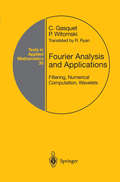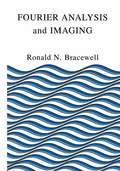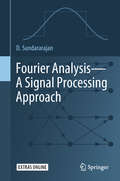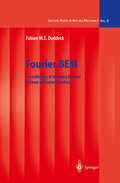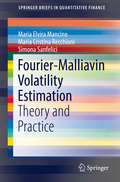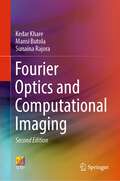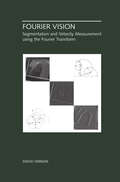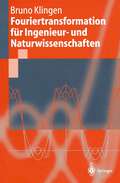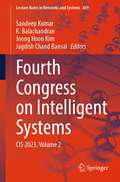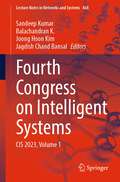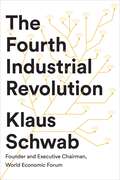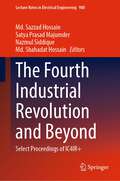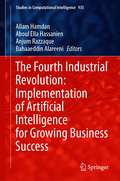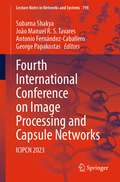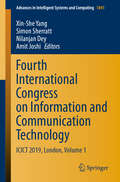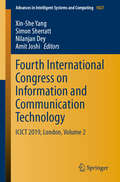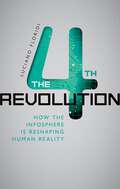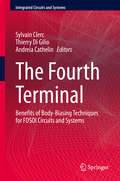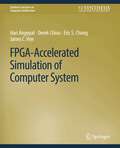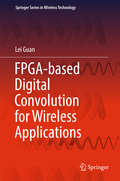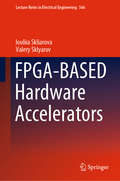- Table View
- List View
Fourier Analysis and Applications: Filtering, Numerical Computation, Wavelets (Texts in Applied Mathematics #30)
by Claude Gasquet Patrick WitomskiFourier Analysis and Imaging
by Ronald BracewellAs Lord Kelvin said, "Fourier's theorem is not only one of the most beautiful results of modern analysis, but it may be said to furnish an indispensable instrument in the treatment of nearly every recondite question in modern physics." This has remained durable knowledge for a century, and has extended its applicability to topics as diverse as medical imaging (CT scanning), the presentation of images on screens and their digital transmission, remote sensing, geophysical exploration, and many branches of engineering. Fourier Analysis and Imaging is based on years of teaching a course on the Fourier Transform at the senior or early graduate level, as well as on Prof. Bracewell's 1995 text Two-Dimensional Imaging. It is an excellent textbook and will also be a welcome addition to the reference library of those many professionals whose daily activities involve Fourier analysis in its many guises.
Fourier Analysis—A Signal Processing Approach
by D. SundararajanThis book sheds new light on Transform methods, which dominate the study of linear time-invariant systems in all areas of science and engineering, such as circuit theory, signal/image processing, communications, controls, vibration analysis, remote sensing, biomedical systems, optics and acoustics. It presents Fourier analysis primarily using physical explanations with waveforms and/or examples, only using mathematical formulations to the extent necessary for its practical use. Intended as a textbook for senior undergraduates and graduate level Fourier analysis courses in engineering and science departments, and as a supplementary textbook for a variety of application courses in science and engineering, the book is also a valuable reference for anyone – student or professional – specializing in practical applications of Fourier analysis. The prerequisite for reading this book is a sound understanding of calculus, linear algebra, signals and systems, and programming at the undergraduate level.
Fourier BEM: Generalization of Boundary Element Methods by Fourier Transform (Lecture Notes in Applied and Computational Mechanics #5)
by Fabian M.E. DuddeckLike FEM, the Boundary Element Method (BEM) provides a general numerical tool for the solution of complex engineering problems. In the last decades, the range of its applications has remarkably been enlarged. Therefore dynamic and nonlinear problems can be tackled. However they still demand an explicit expression of a fundamental solution, which is only known in simple cases. In this respect, the present book proposes an alternative BEM-formulation based on the Fourier transform, which can be applied to almost all cases relevant in engineering mechanics. The basic principle is presented for the heat equation. Applications are taken from solid mechanics (e.g. poroelasticity, thermoelasticity). Transient and stationary examples are given as well as linear and nonlinear. Completed with a mathematical and mechanical glossary, the book will serve as a comprehensive text book linking applied mathematics to real world engineering problems.
Fourier-Malliavin Volatility Estimation: Theory and Practice (SpringerBriefs in Quantitative Finance)
by Maria Elvira Mancino Maria Cristina Recchioni Simona SanfeliciThis volume is a user-friendly presentation of the main theoretical properties of the Fourier-Malliavin volatility estimation, allowing the readers to experience the potential of the approach and its application in various financial settings. Readers are given examples and instruments to implement this methodology in various financial settings and applications of real-life data. A detailed bibliographic reference is included to permit an in-depth study.
Fourier Optics and Computational Imaging
by Kedar Khare Mansi Butola Sunaina RajoraThe book is designed to serve as a textbook for advanced undergraduate and graduate students enrolled in physics and electronics and communication engineering and mathematics. The book provides an introduction to Fourier optics in light of new developments in the area of computational imaging over the last couple of decades. There is an in-depth discussion of mathematical methods such as Fourier analysis, linear systems theory, random processes, and optimization-based image reconstruction techniques. These techniques are very much essential for a better understanding of the working of computational imaging systems. It discusses topics in Fourier optics, e.g., diffraction phenomena, coherent and incoherent imaging systems, and some aspects of coherence theory. These concepts are then used to describe several system ideas that combine optical hardware design and image reconstruction algorithms, such as digital holography, iterative phase retrieval, super-resolution imaging, point spread function engineering for enhanced depth-of-focus, projection-based imaging, single-pixel or ghost imaging, etc. The topics covered in this book can provide an elementary introduction to the exciting area of computational imaging for students who may wish to work with imaging systems in their future careers.
Fourier Vision: Segmentation and Velocity Measurement using the Fourier Transform (The Springer International Series in Engineering and Computer Science #623)
by David VernonFourier Vision provides a new treatment of figure-ground segmentation in scenes comprising transparent, translucent, or opaque objects. Exploiting the relative motion between figure and ground, this technique deals explicitly with the separation of additive signals and makes no assumptions about the spatial or spectral content of the images, with segmentation being carried out phasor by phasor in the Fourier domain. It works with several camera configurations, such as camera motion and short-baseline binocular stereo, and performs best on images with small velocities/displacements, typically one to ten pixels per frame. The book also addresses the use of Fourier techniques to estimate stereo disparity and optical flow. Numerous examples are provided throughout. Fourier Vision will be of value to researchers in image processing & computer vision and, especially, to those who have to deal with superimposed transparent or translucent objects. Researchers in application areas such as medical imaging and acoustic signal processing will also find this of interest.
Fouriertransformation für Ingenieur- und Naturwissenschaften (Springer-Lehrbuch)
by Bruno KlingenDieses Lehrbuch wendet sich an Studenten der Ingenieurfächer und der Naturwissenschaften. Durch seinen systematischen und didaktischen Aufbau vermeidet es ungenaue Formulierungen und legt so die Grundlage für das Verständnis auch neuerer Methoden. Indem die klassische und die Funktionalanalysis auf der Basis des Fourieroperators zusammengeführt werden, vermittelt es ein fundiertes und verantwortbares Umgehen mit der Fouriertransformation. Gleichzeitig bietet dieses Konzept die Möglichkeit, auch die Fourierreihen, die diskrete Fouriertransformation und die Behandlung der diskreten Filter in einem einheitlichen Zusammenhang darzustellen. Das Buch enthält zahlreiche gelöste Übungsaufgaben. NEU ! Online-Ergänzungen zum Buch im Internet: - zum Kennenlernen und Vergleichen der mathematischen Programmiersysteme Mathematica, Matlab, Maple - zur Vertiefung des Buchinhaltes (unter "Extras im Web")
Fourth Congress on Intelligent Systems: CIS 2023, Volume 2 (Lecture Notes in Networks and Systems #869)
by Sandeep Kumar K. Balachandran Joong Hoon Kim Jagdish Chand BansalThis book is a collection of selected papers presented at the Fourth Congress on Intelligent Systems (CIS 2023), organized by CHRIST (Deemed to be University), Bangalore, India, under the technical sponsorship of the Soft Computing Research Society, India, during September 4–5, 2023. It includes novel and innovative work from experts, practitioners, scientists, and decision-makers from academia and industry. It covers topics such as the Internet of Things, information security, embedded systems, real-time systems, cloud computing, big data analysis, quantum computing, automation systems, bio-inspired intelligence, cognitive systems, cyber-physical systems, data analytics, data/web mining, data science, intelligence for security, intelligent decision-making systems, intelligent information processing, intelligent transportation, artificial intelligence for machine vision, imaging sensors technology, image segmentation, convolutional neural network, image/video classification, soft computing for machine vision, pattern recognition, human-computer interaction, robotic devices and systems, autonomous vehicles, intelligent control systems, human motor control, game playing, evolutionary algorithms, swarm optimization, neural network, deep learning, supervised learning, unsupervised learning, fuzzy logic, rough sets, computational optimization, and neuro-fuzzy systems.
Fourth Congress on Intelligent Systems: CIS 2023, Volume 1 (Lecture Notes in Networks and Systems #868)
by Sandeep Kumar Balachandran K. Joong Hoon Kim Jagdish Chand BansalThis book is a collection of selected papers presented at the Fourth Congress on Intelligent Systems (CIS 2023), organized by CHRIST (Deemed to be University), Bangalore, India, under the technical sponsorship of the Soft Computing Research Society, India, during September 4–5, 2023. It includes novel and innovative work from experts, practitioners, scientists, and decision-makers from academia and industry. It covers topics such as the Internet of Things, information security, embedded systems, real-time systems, cloud computing, big data analysis, quantum computing, automation systems, bio-inspired intelligence, cognitive systems, cyber-physical systems, data analytics, data/web mining, data science, intelligence for security, intelligent decision-making systems, intelligent information processing, intelligent transportation, artificial intelligence for machine vision, imaging sensors technology, image segmentation, convolutional neural network, image/video classification, soft computing for machine vision, pattern recognition, human-computer interaction, robotic devices and systems, autonomous vehicles, intelligent control systems, human motor control, game playing, evolutionary algorithms, swarm optimization, neural network, deep learning, supervised learning, unsupervised learning, fuzzy logic, rough sets, computational optimization, and neuro-fuzzy systems.
Fourth IFIP International Conference on Theoretical Computer Science - TCS 2006: IFIP 19th World Computer Congress, TC-1, Foundations of Computer Science, August 23-24, 2006, Santiago, Chile (IFIP Advances in Information and Communication Technology #209)
by Gonzalo Navarro Leopoldo Bertossi Yoshiharu KohayakawaThe papers contained in this volume were presented at the fourth edition of the IFIP International Conference on Theoretical Computer Science (IFIP TCS), held August 23-24, 2006 in Santiago, Chile. They were selected from 44 pa pers submitted from 17 countries in response to the call for papers. A total of 16 submissions were accepted as full papers, yielding an acceptance rate of about 36%. Papers sohcited for IFIP TCS 2006 were meant to constitute orig inal contributions in two general areas: Algorithms, Complexity and Models of Computation; and Logic, Semantics, Specification and Verification. The conference also included six invited presentations: Marcelo Arenas (P- tificia Universidad Catolica de Chile, Chile), Jozef Gruska (Masaryk University, Czech Republic), Claudio Gutierrez (Universidad de Chile, Chile), Marcos Kiwi (Universidad de Chile, Chile), Nicola Santoro (Carleton University, Canada), and Mihalis Yannakakis (Columbia University, USA). The abstracts of those presentations are included in this volume. In addition, Jozef Gruska and Nicola Santoro accepted our invitation to write full papers related to their talks. Those two surveys are included in the present volume as well. TCS is a biannual conference. The first edition was held in Sendai (Japan, 2000), followed by Montreal (Canada, 2002) and Toulouse (France, 2004).
The Fourth Industrial Revolution: What does it mean for Australian Industry?
by Julia Connell John Burgess Alan Nankervis Alan MontagueThis book explores the core themes of the Fourth Industrial Revolution (4IR) highlighting the digital transformation that has been occurring in society and business.Representing an interface between technologies in the physical, digital and biological disciplines the book explores emerging technologies such as artificial intelligence, robotics, the Internet of Things, autonomous vehicles, 3-D printing, nanotechnology, biotechnology, materials science, energy storage, and quantum computing. The findings of collaborative research studies on the potential impact of the 4IR on the labour markets, occupations, future workforce competencies and skills associated with eight industry sectors in Australia are reported. The sectors are: agriculture and mining; manufacturing and logistics; health, medical and nursing; education; retail; financial services; government services and tourism.
The Fourth Industrial Revolution: A Guide To Building A Better World
by Klaus SchwabThe founder and executive chairman of the World Economic Forum on how the impending technological revolution will change our livesWe are on the brink of the Fourth Industrial Revolution. And this one will be unlike any other in human history.Characterized by new technologies fusing the physical, digital and biological worlds, the Fourth Industrial Revolution will impact all disciplines, economies and industries - and it will do so at an unprecedented rate. World Economic Forum data predicts that by 2025 we will see: commercial use of nanomaterials 200 times stronger than steel and a million times thinner than human hair; the first transplant of a 3D-printed liver; 10% of all cars on US roads being driverless; and much more besides.In The Fourth Industrial Revolution, Schwab outlines the key technologies driving this revolution, discusses the major impacts on governments, businesses, civil society and individuals, and offers bold ideas for what can be done to shape a better future for all.
The Fourth Industrial Revolution and Beyond: Select Proceedings of IC4IR+ (Lecture Notes in Electrical Engineering #980)
by Md. Sazzad Hossain Satya Prasad Majumder Nazmul Siddique Md. Shahadat HossainThe book constitutes selected peer-reviewed proceedings of the International Conference on the 4th Industrial Revolution and Beyond (IC4IR 2021). It focuses on the research trends, challenges, and future of artificial intelligence (AI). It explores the potential for the integration of advanced AI algorithms. The book addresses the challenges of Data Science for industrial applications in developing and under-developed countries and various security issues. It includes qualitative and quantitative research and provides case studies with working models. The book focuses on artificial intelligence and its applications for industry, innovation, and infrastructure. The book serves as a reference book for practitioners and researchers working in the areas of AI, soft computing, IoT, and data analytics.
Fourth Industrial Revolution and Business Dynamics: Issues and Implications
by Nasser Rashad Al Mawali Anis Moosa Al Lawati Ananda SThe book explains strategic issues, trends, challenges, and future scenario of global economy in the light of Fourth Industrial Revolution. It consists of insightful scientific essays authored by scholars and practitioners from business, technology, and economics area. The book contributes to business education by means of research, critical and theoretical reviews of issues in Fourth Industrial Revolution.
The Fourth Industrial Revolution: Implementation of Artificial Intelligence for Growing Business Success (Studies in Computational Intelligence #935)
by Allam Hamdan Aboul Ella Hassanien Anjum Razzaque Bahaaeddin AlareeniThis book focuses on the implementation of AI for growing business, and the book includes research articles and expository papers on the applications of AI on decision-making, health care, smart universities, public sector and digital government, FinTech, and RegTech. Artificial Intelligence (AI) is a vital and a fundamental driver for the Fourth Industrial Revolution (FIR). Its influence is observed at homes, in the businesses and in the public spaces. The embodied best of AI reflects robots which drive our cars, stock our warehouses, monitor our behaviors and warn us of our health, and care for our young children. Some researchers also discussed the role of AI in the current COVID-19 pandemic, whether in the health sector, education, and others. On all of these, the researchers discussed the impact of AI on decision-making in those vital sectors of the economy.
Fourth International Conference on Image Processing and Capsule Networks: ICIPCN 2023 (Lecture Notes in Networks and Systems #798)
by Subarna Shakya João Manuel R. S. Tavares Antonio Fernández-Caballero George PapakostasThis book includes high-quality research papers presented at the Fourth International Conference on Image Processing and Capsule Networks (ICIPCN 2023), which is held in Bangkok, Thailand, during 10–11 August 2023. This book provides a collection of the state-of-the-art research attempts to tackle the challenges in image and signal processing from various novel and potential research perspectives. The book investigates feature extraction techniques, image enhancement methods, reconstruction models, object detection methods, recommendation models, deep and temporal feature analysis, intelligent decision support systems, and autonomous image detection models. In addition to this, the book also looks into the potential opportunities to monitor and control the global pandemic situations.
Fourth International Congress on Information and Communication Technology: ICICT 2019, London, Volume 1 (Advances in Intelligent Systems and Computing #1041)
by Xin-She Yang Nilanjan Dey Amit Joshi Simon SherrattThis book gathers selected high-quality research papers presented at the Fourth International Congress on Information and Communication Technology, held at Brunel University, London, on February 27–28, 2019. It discusses emerging topics pertaining to information and communication technology (ICT) for managerial applications, e-governance, e-agriculture, e-education and computing technologies, the Internet of things (IoT), and e-mining. Written by respected experts and researchers working on ICT, the book offers a valuable asset for young researchers involved in advanced studies.
Fourth International Congress on Information and Communication Technology: ICICT 2019, London, Volume 2 (Advances in Intelligent Systems and Computing #1027)
by Xin-She Yang Simon Sherratt Nilanjan Dey Amit JoshiThe second volume of this book includes selected high-quality research papers presented at the Fourth International Congress on Information and Communication Technology, which was held at Brunel University, London, on February 27–28, 2019. It discusses emerging topics pertaining to information and communication technology (ICT) for managerial applications, e-governance, e-agriculture, e-education and computing technologies, the Internet of Things (IoT), and e-mining. Written by respected experts and researchers actively working in ICT, the book offers a valuable resource, especially for researchers who are newcomers to the field.
The Fourth Revolution: How The Infosphere Is Reshaping Human Reality
by Luciano FloridiWho are we, and how do we relate to each other? Luciano Floridi, one of the leading figures in contemporary philosophy, argues that the explosive developments in Information and Communication Technologies (ICTs) is changing the answer to these fundamental human questions. As the boundaries between life online and offline break down, and we become seamlessly connected to each other and surrounded by smart, responsive objects, we are all becoming integrated into an "infosphere". Personas we adopt in social media, for example, feed into our 'real' lives so that we begin to live, as Floridi puts in, "onlife". Following those led by Copernicus, Darwin, and Freud, this metaphysical shift represents nothing less than a fourth revolution. "Onlife" defines more and more of our daily activity - the way we shop, work, learn, care for our health, entertain ourselves, conduct our relationships; the way we interact with the worlds of law, finance, and politics; even the way we conduct war. In every department of life, ICTs have become environmental forces which are creating and transforming our realities. How can we ensure that we shall reap their benefits? What are the implicit risks? Are our technologies going to enable and empower us, or constrain us? Floridi argues that we must expand our ecological and ethical approach to cover both natural and man-made realities, putting the 'e' in an environmentalism that can deal successfully with the new challenges posed by our digital technologies and information society.
The Fourth Terminal: Benefits of Body-Biasing Techniques for FDSOI Circuits and Systems (Integrated Circuits and Systems)
by Sylvain Clerc Thierry Di Gilio Andreia CathelinThis book discusses the advantages and challenges of Body-Biasing for integrated circuits and systems, together with the deployment of the design infrastructure needed to generate this Body-Bias voltage. These new design solutions enable state of the art energy efficiency and system flexibility for the latest applications, such as Internet of Things and 5G communications.
FPGA-Accelerated Simulation of Computer Systems (Synthesis Lectures on Computer Architecture)
by Hari Angepat Derek Chiou Eric S. Chung James C. HoeTo date, the most common form of simulators of computer systems are software-based running on standard computers. One promising approach to improve simulation performance is to apply hardware, specifically reconfigurable hardware in the form of field programmable gate arrays (FPGAs). This manuscript describes various approaches of using FPGAs to accelerate software-implemented simulation of computer systems and selected simulators that incorporate those techniques. More precisely, we describe a simulation architecture taxonomy that incorporates a simulation architecture specifically designed for FPGA accelerated simulation, survey the state-of-the-art in FPGA-accelerated simulation, and describe in detail selected instances of the described techniques. Table of Contents: Preface / Acknowledgments / Introduction / Simulator Background / Accelerating Computer System Simulators with FPGAs / Simulation Virtualization / Categorizing FPGA-based Simulators / Conclusion / Bibliography / Authors' Biographies
FPGA-based Digital Convolution for Wireless Applications (Springer Series in Wireless Technology)
by Lei GuanThis book presents essential perspectives on digital convolutions in wireless communications systems and illustrates their corresponding efficient real-time field-programmable gate array (FPGA) implementations. FPGAs or generic all programmable devices will soon become widespread, serving as the “brains” of all types of real-time smart signal processing systems, like smart networks, smart homes and smart cities. The book examines digital convolution by bringing together the following main elements: the fundamental theory behind the mathematical formulae together with corresponding physical phenomena; virtualized algorithm simulation together with benchmark real-time FPGA implementations; and detailed, state-of-the-art case studies on wireless applications, including popular linear convolution in digital front ends (DFEs); nonlinear convolution in digital pre-distortion (DPD) enabled high-efficiency wireless RF transceivers; and fast linear convolution in massive multiple-input multiple-output (MIMO) systems.After reading this book, students and professionals will be able to:· Understand digital convolution with inside-out information: discover what convolution is, why it is important and how it works.· Enhance their FPGA design skills, i.e., enhance their FPGA-related prototyping capability with model-based hands-on examples.· Rapidly expand their digital signal processing (DSP) blocks: to examine how to rapidly and efficiently create (DSP) functional blocks on a programmable FPGA chip as a reusable intellectual property (IP) core.· Upgrade their expertise as both “thinkers” and “doers”: minimize/close the gap between mathematical equations and FPGA implementations for existing and emerging wireless applications.
FPGA-BASED Hardware Accelerators (Lecture Notes in Electrical Engineering #566)
by Valery Sklyarov Iouliia SkliarovaThis book suggests and describes a number of fast parallel circuits for data/vector processing using FPGA-based hardware accelerators. Three primary areas are covered: searching, sorting, and counting in combinational and iterative networks. These include the application of traditional structures that rely on comparators/swappers as well as alternative networks with a variety of core elements such as adders, logical gates, and look-up tables. The iterative technique discussed in the book enables the sequential reuse of relatively large combinational blocks that execute many parallel operations with small propagation delays. For each type of network discussed, the main focus is on the step-by-step development of the architectures proposed from initial concepts to synthesizable hardware description language specifications. Each type of network is taken through several stages, including modeling the desired functionality in software, the retrieval and automatic conversion of key functions, leading to specifications for optimized hardware modules. The resulting specifications are then synthesized, implemented, and tested in FPGAs using commercial design environments and prototyping boards. The methods proposed can be used in a range of data processing applications, including traditional sorting, the extraction of maximum and minimum subsets from large data sets, communication-time data processing, finding frequently occurring items in a set, and Hamming weight/distance counters/comparators. The book is intended to be a valuable support material for university and industrial engineering courses that involve FPGA-based circuit and system design.
The FPGA Programming Handbook: An essential guide to FPGA design for transforming ideas into hardware using SystemVerilog and VHDL
by Frank Bruno Guy EschemannDevelop solid FPGA programming skills in SystemVerilog and VHDL by crafting practical projects – VGA controller, microprocessor, calculator, keyboard – and amplify your know-how with insider industry knowledge, all in one handbook. Purchase of the print or Kindle book includes a free eBook in PDF formatKey FeaturesExplore a wide range of FPGA applications, grasp their versatility, and master Xilinx FPGA tool flowMaster the intricacies of SystemVerilog and VHDL to develop robust and efficient hardware circuitsRefine skills with CPU, VGA, and calculator projects for practical expertise in real-world applicationsBook DescriptionIn today's tech-driven world, Field Programmable Gate Arrays (FPGAs) are the foundation of many modern systems. Transforming ideas into reality demands a deep dive into FPGA architecture, tools, and design principles. This FPGA book is your companion to mastering FPGA development with SystemVerilog and VHDL. In this edition, you will master both SystemVerilog and VHDL, gaining supreme versatility in FPGA design. These skills open doors to diverse opportunities and projects in the field. Move beyond theory with real-world projects, starting from LED control and progressing to advanced microcontroller applications, which are highly sought after in today's FPGA job market. You will journey from basic Boolean logic circuits to a resource-optimized calculator, showcasing your hardware design prowess. You will elevate your knowledge by designing a Video Graphics Array (VGA) controller, demonstrating your ability to synthesize complex hardware systems. You can use this handbook as your FPGA development guide, where you will master intricacies, ignite creativity, and emerge with the expertise to craft hardware circuits using SystemVerilog and VHDL. The FPGA Programming Handbook isn't just another technical manual; it's your exhilarating journey to master theory and practice, accelerating your FPGA design skills to soaring new heights.What you will learnUnderstand the FPGA architecture and its implementationGet to grips with writing SystemVerilog and VHDL RTLMake FPGA projects using SystemVerilog and VHDL programmingWork with computer math basics, parallelism, and pipeliningExplore the advanced topics of AXI and keyboard interfacing with PS/2Discover how you can implement a VGA interface in your projectsExplore the PMOD connectors-SPI and UART, using Nexys A7 boardImplement an embedded microcontroller in the FPGAWho this book is forThis FPGA design book is for embedded system developers, engineers, and programmers who want to learn FPGA design using SystemVerilog or VHDL programming from scratch. FPGA designers looking to gain hands-on experience in working on real-world projects will also find this book useful.
